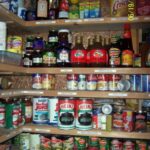As the manager of a local food pantry, I keep a pretty close eye on donated food. While most of the canned and boxed food we receive is fresh, we often see donations of food that looks like they were cleared out of grandma’s kitchen. Some things just look old, like the pickles with the 19¢ price tag. Canned food with rust, dents, or bulges get tossed immediately. Food without labels also gets pitched. But, what about the rest of the food? How do we know if it is safe to eat and where do we find the expiration dates?
Shelf life is determined by the manufacturer. They set this time frame to ensure the maximum freshness and nutrition of the item. Once the item hits the expiration date, the texture and nutrition begin to change. While most older canned food isn’t harmful unless the can has been damaged, the nutrition levels do drop. The texture of the food also changes; fruits and vegetables become mushier and fade in color.
With boxed foods, the quality of the product visibly declines with age. Rice and pasta dry out and cereal becomes crumbly. The leavening agents in cake mixes and biscuit mix become unstable and will rise unevenly. There is also a high chance of infestation by weevils. Weevils occur naturally in grains and after long periods of time, their eggs can hatch. Once weevils have infested the cabinets, all boxed goods will have to be thrown out and the shelves disinfected.
How to read the expiration dates
All manufacturers use some sort of coding system to mark their products. The systems vary and can be a little tough to decipher.
For the past few years, almost all manufacturers of boxed or packaged goods now use a ‘best by’ date. Best by” is the last day that maximum freshness and quality can be assured. On boxed goods such as cereal or rice a roni, this number should be found imprinted on the top flap. Some varieties stamp this number on the base. Packaged pasta and rice will usually have the number printed some on the bag either beneath the label, or on the back. Salad dressings, mayonnaise, and peanut butter also use a “best by’ date which is usually stamped somewhere on the neck or along the base.
Canned goods are a little tougher to figure out. Del Monte and Campbell’s are two companies that use a clearly marked “Best by” date. Many other manufacturers continue to use a code that it hard to decipher. These codes can mean a lot of different things; plant location, time of day and so on. However, within that series of numbers, you will find either an expiration or processing date. Some are written in Julian calendar form, others use a combination of letters and numbers.
To decipher these numbers, a down loadable file called Food Shelf Life Recommendations is a helpful and comprehensive guide. It lists dozen of manufacturers and food types, and explains how to read the expiration codes in easy-to-understand language. The web address is listed in the resource section at the end of this article. While this reference does contain most production codes, it doesn’t contain all of them. In these cases, you should call the toll free number listed on the side of your canned food item.
The rule of thumb at many food banks is that most canned food is good for 2 years past the expiration date. This presumes that the canned food item has been stored at moderate temperatures, and is undamaged. Boxed cereal must be tossed within 3 months of the expiration date, and boxed mixes & pastas usually have an additional shelf life for a year past the “Best By” date.
The best practice is to keep all food stored at proper temperatures, and rotate it by date. Check the cans for signs of damage and try to eat it before it expires for the optimum freshness and nutrition. If you are uncertain about the quality of an item, it is always safest to defer to that old adage, “When in doubt, throw it out.”




